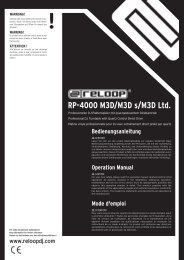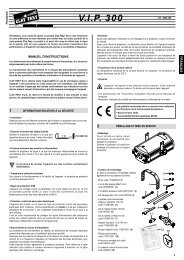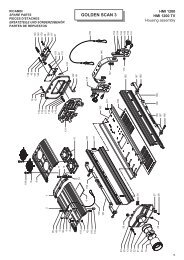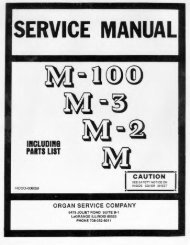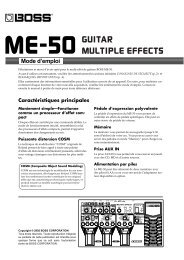Create successful ePaper yourself
Turn your PDF publications into a flip-book with our unique Google optimized e-Paper software.
300 V 3.0 <strong>Owner's</strong> <strong>Manual</strong>SPRD (Spread)<strong>Lexicon</strong>SPRD works together with SHAP to control the duration of the initial ambiencecreated by the 300. Low SPRD settings result in a rapid onset of reverberationat the beginning of the envelope, with little or no sustain. Higher settings spreadout both the buildup and sustain.Split Chamber Adjustments Page 2BASS (Bass Multiply)BASS sets the reverb time for low-frequency signals, as a multiplier of the RTIMparameter. For example, if BASS is set to 2X, and RTIM is set to two seconds,the low frequency reverb time will be four seconds. For a natural-sounding hallambience, we recommend values of 1.5X or less.DIFF (Diffusion)DIFF controls the degree to which initial echo density increases over time. Highsettings of DIFF result in high initial buildup of echo density; low settings causelow initial buildup. Echo density is also affected by SIZE; smaller spaces willsound denser. To enhance percussion, use high settings of DIFF. For clearer,more natural vocals, mixes, and music, use low or moderate settings.RAND (Randomization)RAND sets the distance in time that the early reflections will move.XOVR (Bass Crossover)XOVR sets the frequency at which the transition from RTIM to BASS takes place.XOVR should be set at least two octaves higher than the low frequency you wantto boost. For example, to boost a signal at 100 Hz, set XOVR to 400 Hz (Thissetting works well for classical music). XOVR works best around 400 for boostinglow frequencies, and around 1.5 kHz for cutting low frequencies.LINKWhen LINK is set, the reverb time and spread values scale linearly as the SIZEcontrol is varied. For some special effects, RTIM and SPRD can be unlinked.4-28





